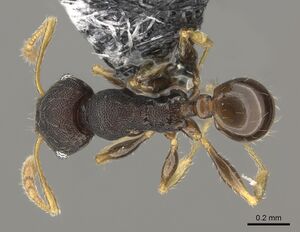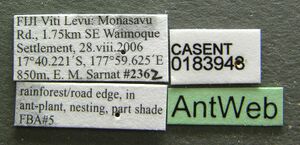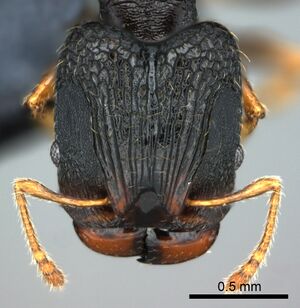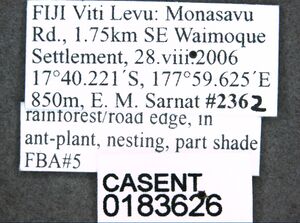Pheidole kava
| Pheidole kava | |
|---|---|

| |
| Scientific classification | |
| Kingdom: | Animalia |
| Phylum: | Arthropoda |
| Class: | Insecta |
| Order: | Hymenoptera |
| Family: | Formicidae |
| Subfamily: | Myrmicinae |
| Tribe: | Attini |
| Genus: | Pheidole |
| Species group: | knowlesi |
| Species: | P. kava |
| Binomial name | |
| Pheidole kava Fischer, Sarnat & Economo, 2016 | |
Pheidole kava is relatively rarely collected. It was found on only three of the sampled islands (Viti Levu, Gau, and Koro) from elevations ranging betwen 300 and 850m. Pheidole kava was collected from leaf-litter, foraging on the ground, from nests inside dead branches, under stones and in ant plants. Its habitat seems to be restricted to rainforest and bryophyte forest. (Fisher et al. 2016)
Identification
Fisher et al. (2016) - knowlesi group: Major worker: small (WL 0.85–0.97mm); head heavily sculptured with coarsely rugoreticulate posterolateral lobes, broad and punctate antennal scrobes; anterior clypeal margin straight without median notch; in profile, head impressed between frons and posterior head margin and lobes; gaster smooth, except for superficially punctate spot anteriorly near postpetiole. Minor worker: promesonotal profile low with relatively short, oblique mesonotal declivity; sculpture on head and body uniformly punctate, except for smooth head venter, postpetiole dorsum, and gaster. Queen: small (WL 1.12–1.36mm), with short legs (FI 69–72); anterior clypeal margin transverse without median notch; head sculpture between longitudinal rugae punctate, rugae near posterior head margin reticulate; gaster smooth, sometimes with weakly rugopunctate area anterodorsally near postpetiole.
The Koro major worker specimens deviate slightly from those of Gau and Viti Levu by a more smooth and shiny lateral mesosoma, a slightly deeper impression between the frons and the posterior margin of head, and a postpetiole that is wider and more smooth and shiny in dorsal view. Major workers of Pheidole kava are most similar to those of Pheidole vatu in head sculpture and size. Workers and queens of the two species tend to be the smallest in the knowlesi group. The majors of P. kava can be easily distinguished by an almost completely punctate versus a mostly smooth and shiny mesosoma in P. vatu and by absence of a median clypeal notch in P. kava. The queens of these two species also share several characters, such as the smaller size and the flatter mesosoma shape in profile. In contrast, the minor workers of P. kava are most similar to those of Pheidole ululevu. They are almost exclusively distinguishable by the extent of punctures present on the head. While the minors have dense punctures on the head dorsum, but a smooth head venter in P. kava, the heads are densely punctate dorsally and ventrally in P. ululevu. In the workers of P. vatu, the promesonotum is also significantly higher domed than in P. kava and the other knowlesi group species. Interestingly, Pheidole kava displays a rather large variability in the expression of the major workers’ hypostomal teeth (see description).
Keys including this Species
- Key to Pheidole knowlesi group minors
- Key to Pheidole knowlesi group majors
- Key to Pheidole knowlesi group queens
Distribution
Latitudinal Distribution Pattern
Latitudinal Range: -17.6703° to -17.6703°.
| North Temperate |
North Subtropical |
Tropical | South Subtropical |
South Temperate |
- Source: AntMaps
Distribution based on Regional Taxon Lists
Indo-Australian Region: Fiji (type locality).
Distribution based on AntMaps
Distribution based on AntWeb specimens
Check data from AntWeb
Countries Occupied
| Number of countries occupied by this species based on AntWiki Regional Taxon Lists. In general, fewer countries occupied indicates a narrower range, while more countries indicates a more widespread species. |

|
Estimated Abundance
| Relative abundance based on number of AntMaps records per species (this species within the purple bar). Fewer records (to the left) indicates a less abundant/encountered species while more records (to the right) indicates more abundant/encountered species. |

|
Biology
Castes
Worker
Minor
Images from AntWeb
   
| |
| Not Provided. Worker. Specimen code casent0183943. Photographer Shannon Hartman, uploaded by California Academy of Sciences. | Owned by EMSC. |
Major
Images from AntWeb
   
| |
| Not Provided. Worker (major/soldier). Specimen code casent0183626. Photographer Evan P. Economo, uploaded by California Academy of Sciences. | Owned by EMSC. |
Phylogeny
| remaining Pheidole |
| |||||||||||||||||||||||||||||||||||||||
Relationships of knowlesi group species based on Economo et al. (2015) and Fischer et al. (2016). One member of the group, Pheidole caldwelli, is not represented due to lack of molecular data.
Nomenclature
The following information is derived from Barry Bolton's Online Catalogue of the Ants of the World.
- kava. Pheidole kava Fischer, Sarnat & Economo, 2016: 18, figs. 3D–3F, 7, S4–S6 (videos) (w.q.) FIJI IS.
Unless otherwise noted the text for the remainder of this section is reported from the publication that includes the original description.
Description
Worker
Major (n = 7): HW 0.94–1.06 (0.99), HL 1.00–1.10 (1.05), SL 0.46–0.52 (0.50), MDL 0.45–0.57 (0.53), EL 0.15–0.18 (0.16), WL 0.85–0.97 (0.92), PNW 0.56–0.65 (0.59), PTL 0.34–0.38 (0.36), PPL 0.18–0.21 (0.19), PTH 0.21–0.25 (0.22), PPH 0.22–0.25 (0.23), PTW 0.18–0.20 (0.19), PPW 0.35–0.45 (0.40), PSL 0.17–0.20 (0.19), MFL 0.56–0.66 (0.62), MTL 0.43–0.48 (0.46), CI 92–96 (94), SI 48–53 (51), MDI 46–59 (53), EI 15–18 (16), FI 58–66 (63), PpI 61–75 (67), LPpI 78–91 (83), DPpI 184–228 (207), PpWI 189–225 (211), PpHI 100–110 (103). Ground sculpture punctate to weakly punctate on head dorsum, mesosoma, lateroventral petiole and postpetiole. Spaces between rugae on frons and posterolateral lobes, on propodeal dorsum and posterior declivity, and on anterodorsal gaster superficially punctate. Mandibles, clypeus, most of head venter, dorsal waist segments and majority of gaster smooth and shiny. Head rectangular, sides parallel, posteriorly about as wide as anteriorly or slightly narrower. Anterior margin of clypeus transverse to weakly impressed medially. Head in profile slightly impressed between frons and posterodorsal lobes. Frons slightly convex in profile view and in full-face view slightly elevated compared to sides and posterolateral lobes, with well-defined longitudinal rugae, rarely with a single median ocellus present. Posteriorly, rugae becoming weakly reticulate, posterolateral lobes coarsely rugoreticulate. Sides of head punctate with weakly rugoreticulate parts. Scrobe area punctate, well-defined by long, laterally-curving frontal carinae and relatively strongly depressed posteriorly towards sides of the head. Carinae reaching to posterior end of antennal scapes when in repose, but ending well before posterior lobes. Scape length about ½ of head width (SI 48–53), almost reaching posterior 1/3 of head, with short, mostly decumbent pilosity and few longer erect hairs along outer edge. Hypostomal teeth variable, usually with a pronounced and wide median tooth and two shorter submedian teeth (Viti Levu), but sometimes only two submedian and median tooth almost absent, or with a very big median tooth and two very reduced submedian teeth (Gau). Promesonotum in profile convex without posterior process, obtusely angulate towards steep posterior declivity. Metanotal groove not impressed, propodeum short and compact, significantly higher than long in profile, with oblique dorsal face, declining towards moderately long and slender spines. In dorsal view, pronotal humeri weakly projecting. Mesosoma punctuate and transversely rugoreticulate on katepisternum and dorsopropodeum, and sometimes on lateral pronotum and propodeum (Gau, Koro), with superficial sculpture or smooth. Metatibia pilosity mostly fine, decumbent with very few suberect hairs along outer edge. Petiole and postpetiole laterally and ventrally weakly punctate, dorsomedially smooth. Gaster smooth and shiny with weakly to superficially punctate area anteriorly near postpetiole. Standing hairs suberect, relatively flexuous and abundant, on gaster longer and with a relatively thicker base, shorter pilosity decumbent.
Minor (n = 7): HW 0.37–0.45 (0.41), HL 0.40–0.48 (0.44), SL 0.34–0.43 (0.40), MDL 0.23–0.29 (0.26), EL 0.09–0.11 (0.10), WL 0.45–0.56 (0.51), PNW 0.25–0.30 (0.28), PTL 0.16–0.24 (0.20), PPL 0.08–0.10 (0.09), PTH 0.09–0.12 (0.10), PPH 0.08–0.11 (0.10), PTW 0.07–0.09 (0.08), PPW 0.12–0.16 (0.14), PSL 0.08–0.10 (0.09), MFL 0.33–0.41 (0.37), MTL 0.24–0.30 (0.27), CI 91–96 (93), SI 93–100 (96), MDI 61–67 (64), EI 24–27 (25), FI 89–92 (90), PpI 47–56 (50), LPpI 87–100 (92), DPpI 142–164 (154), PpWI 150–180 (165), PpHI 89–96 (93). Head dorsum, mesosoma and petiole laterally coarsely punctate. Mandibles, clypeus, majority of head venter, petiole dorsum medially, postpetiole and gaster smooth and shiny. Head subrectangular, sides weakly convex, posterior margin wide and medially slightly concave, posterior corners rounded. Eyes relatively small, with 6 ommatidia in the longest row. Scapes reaching and barely surpassing posterior head margin, scape pilosity decumbent to subdecumbent with few, very short suberect hairs along outer edge. Promesonotal outline in profile compact, convex, with steep but short posterior declivity, metanotal groove very shallow, with barely visible crossribs, propodeum distinctly higher than long, spines relatively short-spinose, acute, distinctly shorter than distance between their bases. Metatibia pilosity mostly decumbent. Postpetiole almost as high as petiole (PpHI 89–96), slightly higher than long (LPpI 87–100), in dorsal view about 1.5 times wider than long (DPpI 142–164). Long standing hairs on head and mesosoma almost absent, with only few hairs on head and on gaster longer than sparse, short and relatively coarse, decumbent to suberect pilosity. Head and body dark brown, mandibles, antennae, tibiae and tarsi yellow.
Queen
(n = 3): HW 0.80–0.96 (0.88), HL 0.78–0.91 (0.84), SL 0.46–0.57 (0.51), MDL 0.46–0.57 (0.51), EL 0.24–0.27 (0.26), WL 1.12–1.36 (1.22), PNW 0.68–0.87 (0.75), PTL 0.41–0.51 (0.45), PPL 0.21–0.31 (0.24), PTH 0.25–0.28 (0.27), PPH 0.25–0.29 (0.27), PTW 0.22–0.27 (0.24), PPW 0.45–0.46 (0.46), PSL 0.19–0.24 (0.21), MFL 0.57–0.75 (0.64), MTL 0.42–0.57 (0.49), CI 102–105 (104), SI 57–59 (58), MDI 56–59 (58), EI 28–30 (29), FI 69–72 (70), PSLI 23–25 (24), LPpI 54–84 (70), DPpI 214–219 (217), PpWI 196–205 (200), PpHI 76–104 (93). Head slightly wider than long (CI 102–105). Anterior margin of clypeus transverse, without distinctly concave median notch. Scapes relatively short (SI 57–59), pilosity mostly decumbent with longer suberect hairs along outer edge. Head dorsum punctate, with longitudinal rugae, the rugae becoming slightly reticulate near posterior head margin. Hypostomal margin with broad, well-developed median tooth and submedian teeth also large, but narrower. Oblique carinae on scutum not reaching anterior margin in anterodorsal view. Mesosoma mostly smooth and shiny, but lateropronotum punctate-rugulose and weak to superficial punctures present at anterior and lateral pronotum, posterior anepisternum, and lateropropodeum, propodeum laterally also with abundant oblique rugulae. Petiole laterally and often dorsally weakly punctate. Postpetiole about twice as wide as petiole (PpWI 196–205), dorsally smooth, its anterior margin in dorsal view convex, lateral corners widely extended. Gaster smooth, sometimes with weakly rugopunctate area anteriorly near postpetiole. Standing hairs moderately long and abundant, suberect and yellow. Color black or dark brown, anterior of head, mandibles, antennae and legs lighter colored.
Type Material
Holotype: Major worker (Bernice P. Bishop Museum, specimen code CASENT0183620), FIJI, Viti Levu, Monasavu Rd., 1.75km SE Waimoque Settlement, -17.6703, 177.994, 850m, rainforest/road edge, nesting in ant plant, 28.viii.2006 (E.M. Sarnat). Paratypes: 4 major workers (Museum of Comparative Zoology, CASENT0183863; National Museum of Natural History, CASENT0183925; CASENT0183626; CASENT0183675), 3 minor workers (BPBM, CASENT0183943; MCZC, CASENT0183979; USNM, CASENT0183982), 1 dealate queen, same data as holotype (CASENT0183961).
Etymology
This species is named after the Pacific islands’ mildly narcotic drink, which is brewed from the roots of the kava plant (Piper methysticum). The name is a noun in apposition and thus invariant.
Determination Clarifications
Previously treated at morphospecies, P. FJ05.
References
References based on Global Ant Biodiversity Informatics
- Fischer G., E. M. Sarnat, and E. P. Economo. 2016. Revision and microtomography of the Pheidole knowlesi Group, an endemic ant radiation in Fiji (Hymenoptera, Formicidae, Myrmicinae). PLoS ONE 11(7): e0158544. doi:10.1371/journal.pone.0158544

